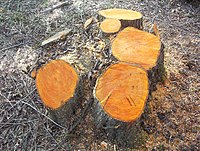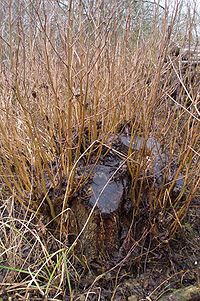Coppicing
Coppicing
Many silviculture practices involve cutting and regrowth; coppicing has been of significance in many parts of lowland temperate Europe.[citation needed] The widespread and long-term practice of coppicing as a landscape-scale industry is something that remains of special importance in southern England.[4] Many of the English language terms referenced in this article are particularly relevant to historic and contemporary practice in that area.
Typically a coppiced woodland is harvested in sections or coups[5] on a rotation. In this way, a crop is available each year somewhere in the woodland. Coppicing has the effect of providing a rich variety of habitats, as the woodland always has a range of different-aged coppice growing in it, which is beneficial for biodiversity. The cycle length depends upon the species cut, the local custom, and the use of the product. Birch can be coppiced for faggots on a three- or four-year cycle, whereas oak can be coppiced over a fifty-year cycle for poles or firewood.
Trees being coppiced do not die of old age as coppicing maintains the tree at a juvenile stage, allowing them to reach immense ages.[1] The age of a stool may be estimated from its diameter; some are so large—as much as 5.5 metres (18 ft) across—that they are thought to have been continually coppiced for centuries.[6]
History
Evidence suggests that coppicing has been continuously practised since pre-history.[7] Coppiced stems are characteristically curved at the base. This curve occurs as the competing stems grow out from the stool in the early stages of the cycle, then up toward the sky as the canopy closes.[citation needed] The curve may allow the identification of coppice timber in archaeological sites. Timber in the Sweet Track in Somerset (built in the winter of 3807 and 3806 BCE) has been identified as coppiced Tilia species.[7]
Originally, the silvicultural system now called coppicing was practiced solely for small wood production.[
In the 16th and 17th centuries, the technology of charcoal iron production became widely established in England, continuing in some areas until the late 19th century[9] Along with the growing need for oak bark for tanning, this required large amounts of coppice wood. With this coppice management, wood could be provided for those growing industries in principle indefinitely. This was regulated by a statute of 1544[10] of Henry VIII, which required woods to be enclosed after cutting (to prevent browsing by animals) and 12 standels (standards or mature uncut trees) to be left in each acre, to be grown into timber. Coppice with standards (scattered individual stems allowed to grow on through several coppice cycles) has been commonly used throughout most of Europe[when?] as a means of giving greater flexibility in the resulting forest product from any one area. The woodland provides the small material from the coppice as well as a range of larger timber for such uses as house building, bridge repair, cart-making and so on.
In the 18th century coppicing in Britain began a long decline. This was brought about by the erosion of its traditional markets. Firewood was no longer needed for domestic or industrial uses as coal and coke became easily obtained and transported, and wood as a construction material was gradually replaced by newer materials.[citation needed] Coppicing died out first in the north of Britain and steadily contracted toward the south-east until by the 1960s active commercial coppice was heavily concentrated in Kent and Sussex.[11]
Practice
The shoots (or
Another, more complicated system is called compound coppice. Here some of the standards would be left, some harvested. Some of the coppice would be allowed to grow into new standards and some regenerated coppice would be there. Thus there would be three age classes.[12] Coppiced hardwoods were used extensively in carriage and shipbuilding, and they are still sometimes grown for making wooden buildings and furniture.

Withies for wicker-work are grown in coppices of various willow species, principally osier.
In France, sweet chestnut trees are coppiced for use as canes and bâtons for the martial art Canne de combat (also known as Bâton français).
Some Eucalyptus species are coppiced in a number of countries, including Australia, North America, Uganda, and Sudan.[13][14]
The Sal tree is coppiced in India,[15] and the Moringa oleifera tree is coppiced in many countries, including India.
Sometimes former coppice is converted to
The boundaries of coppice coups were sometimes marked by cutting certain trees as pollards or stubs.
United Kingdom


In
Coppices provided wood for many purposes, especially
In
Wildlife
Coppice management favours a range of wildlife, often of species adapted to open woodland.
However, most British coppices have not been managed in this way for many decades.
Natural occurrence
Coppice and pollard growth is a response of the tree to damage, and can occur naturally. Trees may be

For energy wood
Coppicing of
Species and cultivars vary in when they should be cut, regeneration times and other factors. However, full
Gallery
-
Ash coppice stool
-
Bluebells among coppice in Bysing Wood, Kent
-
Hornbeam coppice, Pond Wood, Essex
-
Ash coppice in Overlangbroek, Netherlands
-
Coppicing in progress, note standard trees among the coppice stools, Lower Wood, Norfolk
See also
- Ancient woodland
- Apical dominance
- Basal shoot
- Bodging
- Coarse woody debris
- Crown sprouting
- Epicormic shoot
- Even aged timber management
- Fire ecology
- Layering
- Lignotuber
- Mallee (habit)
- Pollarding
- Pruning
- Short rotation coppice
- Shredding (tree pruning technique)
- Silvopasture
- Stand level modelling
- Thinning
- Tree topping
References
- ^ a b De Decker, Kris (n.d.). "How to Make Biomass Energy Sustainable Again". Low-Tech Magazine. Retrieved 27 April 2021.
- ^ "Incredible 15th-Century Japanese Technique for Growing Ultra-Straight Cedar Trees". My Modern Met. 31 July 2020. Retrieved 19 August 2020.
- ^ Taaffe, Gerard (26 September 2002). "Trees that tower over the past and present". The Japan Times. Retrieved 19 August 2020.
...known as dai-sugi. This is a coppiced sugi ...
- . Retrieved 1 January 2024.
- ^ Coup (French coup, 'cut') is pronounced /ˈkuːp/ in this context.
- ^ Rackham, Oliver (1980). "The medieval landscape of Essex" (PDF). In D. G. Buckley (ed.). Archaeology in Essex to AD 1500 (Report). CBA Research Reports. The Council for British Archaeology. p. 104. Retrieved 25 July 2022.
- ^ a b Coles, J M (1978). Limbrey, Susan and J G Evans (ed.). "Man and landscape in the Somerset Levels" (PDF). The Effect of Man on the Landscape: The Lowland Zone. London: 86–89. Archived from the original (PDF) on 27 September 2011. Retrieved 13 September 2007.
- ^ "A Critique of Silviculture Managing for Complexity" Chapter 1 Historical Context of Silviculture Puettmann, K.J. et al. 2009
- ^ "Coppicing – A Brief History". Wandering Woodsmen - Woodland & Countryside Conservation. Retrieved 12 June 2018.
- ^ Forestry in the Weald, Forestry Commission Booklet 22, C. Barrington 1968
- ^ a b c d Fuller, R J; Warren, M S. "Coppiced woodlands: their management for wildlife" (PDF). JNCC. Archived from the original (PDF) on 9 September 2011. Retrieved 6 November 2017.
- ^ Silviculture Concepts and Applications, Ralph D. Nyland 2002 p. 563
- ISBN 978-0198594918.
- ^ Hamilton, Liz (June 2000). "Managing coppice in Eucalypt plantations". Trees & Native Vegetation: Farm Forestry. Department of Primary Industries, Victoria, Australia. Retrieved 17 April 2008.
- ^ "coppice on sal tree (Shorea robusta ) – 2714050". 3 February 2003. Retrieved 29 April 2014.
- ISBN 1-897604-27-0.
- ^ The Bill Hogarth MBE Memorial Apprenticeship Trust Retrieved 17 June 2014
- ^ "Coppicing at the Museum". Weald and Downland Living Museum. 27 January 2023. Retrieved 31 January 2023.
- ISBN 2-904740-16-3Cite: [...] rejette mal de souche à l'étage collinéen, mais très facilement à l'étage montagnard ; (Does not coppice well in the foothill zone but very easily in the montane zone).
- ^ Dimitriou, Ioannis; Aronsson, Pär (2005). "Willows for energy and phytoremediation in Sweden". Food and Agriculture Organization. Retrieved 29 August 2021.
- ^ Silviculture Concepts and Applications, Ralph D. Nyland 2002 Ch. 24 "Coppice Silviculture"
- ^ Poplar (Populus spp.) Trees for Biofuel Production by Patricia A. Townsend, et al. extension.org
Further reading
- ISBN 1-84212-469-2.
- Hammersley, G, 'The charcoal iron industry and its fuel 1540–1750' Econ Hist. Rev. Ser. II, 26 (1973), 593–613.
External links
 Media related to Coppices at Wikimedia Commons
Media related to Coppices at Wikimedia Commons The dictionary definition of coppicing at Wiktionary
The dictionary definition of coppicing at Wiktionary- What is coppicing? The National Trust







